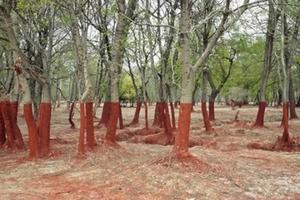Chemical spillsHungarian red mud spill did little long-term damage
The aftereffects of the 2010 red mud spill that threatened to poison great swathes of the Hungarian countryside have turned out to be far less harmful than scientists originally feared. The disaster happened when weeks of heavy rain caused a dam to collapse at a containment facility in Ajka in Western Hungary. It released around a million cubic meters of toxic sludge into the Torna-Marcal river system, onto the Hungarian plain and ultimately into the Danube. The mud, a byproduct of refining aluminum from bauxite ore, was dangerously alkaline, extremely salty and contained potentially toxic metals like chromium and vanadium.

Tree trunks show the depth of the mud spill at its worst // Source: miyanali.com
The aftereffects of the 2010 red mud spill that threatened to poison great swathes of the Hungarian countryside have turned out to be far less harmful than scientists originally feared.
The disaster happened when weeks of heavy rain caused a dam to collapse at a containment facility in Ajka in Western Hungary. It released around a million cubic meters of toxic sludge into the Torna-Marcal river system, onto the Hungarian plain and ultimately into the Danube.
The mud, a byproduct of refining aluminum from bauxite ore, was dangerously alkaline, extremely salty and contained potentially toxic metals like chromium and vanadium. And this was the first time red mud had ever been released into the environment in such large quantities. We didn’t know exactly what the effects would be, but some commentators feared the long-term effects on people and wildlife could be severe.
But a new study in Environmental Science: Processes & Impacts shows that there’s hardly any trace left of the red mud in the Tornar and Marcal rivers downstream of the spill.
“It’s a good news story,” says Dr .Will Mayes of the University of Hull, the paper’s senior author. “Our results show that the combined effect of the structure of the sediment and the Hungarian government’s remediation efforts have mostly dealt with the spill’s aftereffects — we found the geochemical signal from the red mud has almost completely disappeared.”
Things turned out so well partly because the Hungarian government acted quickly, spending around €127 million on dredging mud out of rivers and removing it from the flood plain, as well as dosing it with acid near the source of the spill and then adding gypsum further away in an effort to reduce its dangerous levels of alkalinity.
The fine-grained nature of the red mud also meant that in many areas any sludge that didn’t get cleaned up was quickly washed downstream and into the Danube river, which is so huge that it was soon diluted to the point of harmlessness and flowed out to sea.
“There was a lot of red mud, but in the context of the Danube river system’s size and rate of flow it doesn’t seem to have had much impact,” Mayes explains.
He received urgency funding from NERC [U.K. Natural Environment Research Council] in the immediate aftermath of the spill; his team travelled to Hungary and worked with Hungarian geoscientists to test sediments in the rivers downstream. At the time they found
